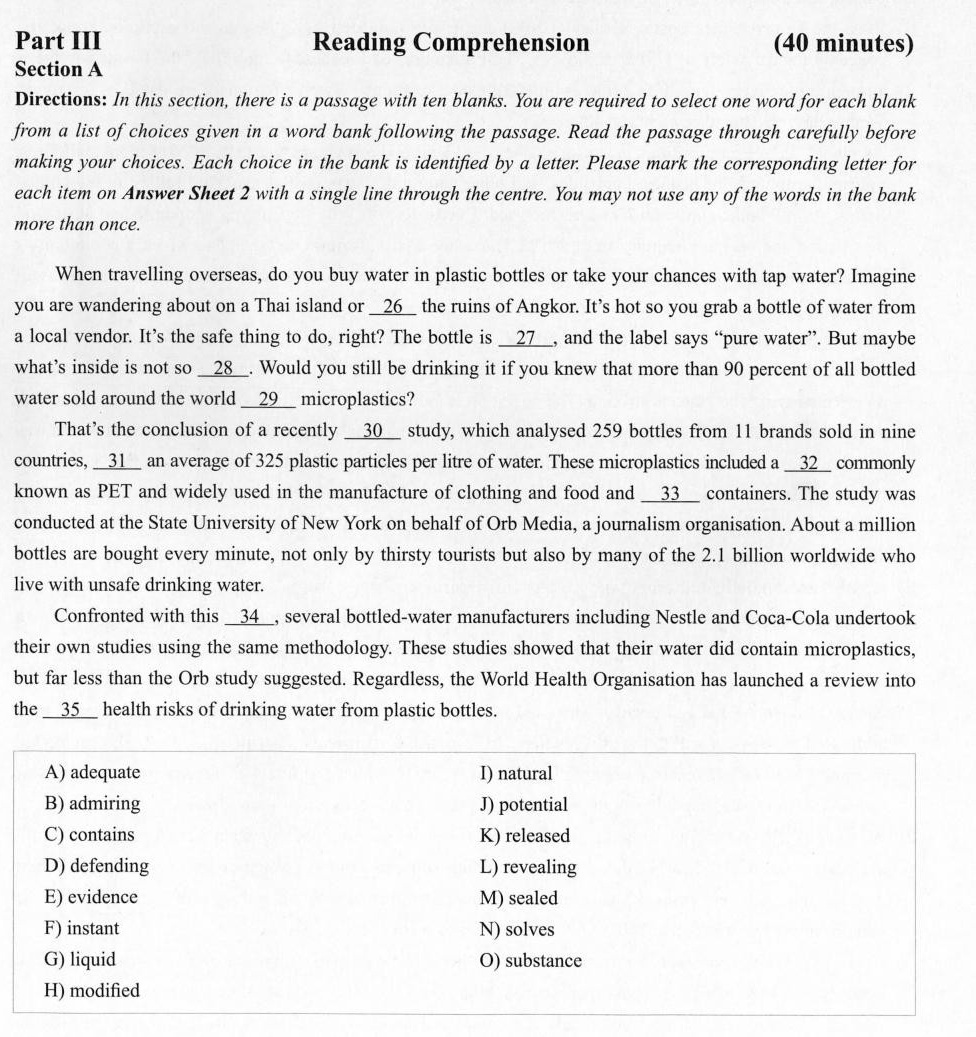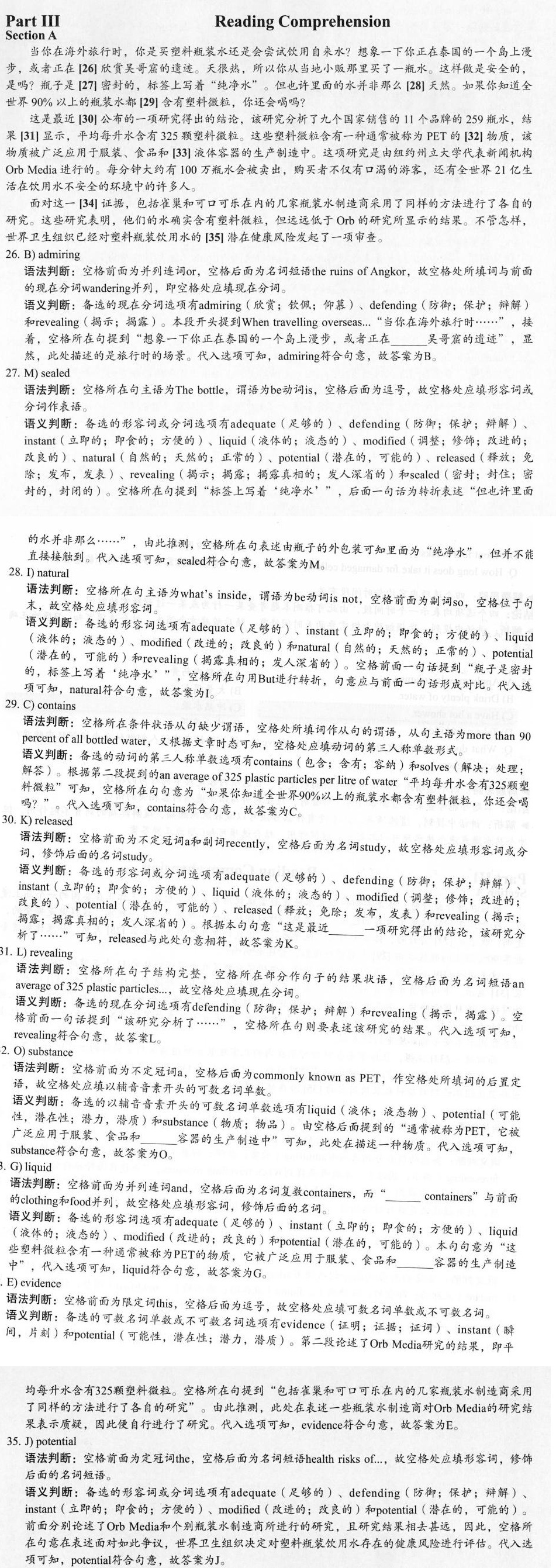题目
Part III Reading Comprehension 40minutes)-|||-Section A-|||-Directions:In this section,there is a passage with ten blanks.You are required to select one word for each blank-|||-from a list of choices given in a word bank following the passage. Read the passage through carefully before-|||-making your choices.Each choice in the bank is identified by a letter.Please mark the corresponding letter for-|||-each item on Answer Sheet 2 with a single line through the centre. You may not use any of the words in the bank-|||-more than once.-|||-When travelling overseas,do you buy water in plastic bottles or take your chances with tap water? Imagine-|||-you are wandering about on a Thai island or 26 the ruins of Angkor.It`s hot so you grab a bottle of water from-|||-a local vendor.It`s the safe thing to do,right? The bottle is 27 and the label says "pure water".But maybe-|||-what`s inside is not so 28 Would you still be drinking it if you knew that more than 90 percent of all bottled-|||-water sold around the world 29 microplastics?-|||-That`s the conclusion of a recently 30 study,which analysed 259 bottles from 11 brands sold in nine-|||-countries, 31 an average of 325 plastic particles per litre of water.These microplastics included a 32 commonly-|||-known as PET and widely used in the manufacture of clothing and food and 33 containers.The study was-|||-conducted at the State University of New York on behalf of Orb Media,a journalism organisation About a million-|||-bottles are bought every minute,not only by thirsty tourists but also by many of the 2.1 billion worldwide who-|||-live with unsafe drinking water.-|||-Confronted with this 34 several bottled-water manfactureinchading Nestl and Coca-Cola undertook-|||-their own studies using the same methodology. These studie showed that their water did contain microplastics,-|||-but far less than the Orb study suggested. Regardle the World Health Organisation has launched a review into-|||-the 35 health risks of drinking water from plastic bottles.-|||-A)adequate I) natural-|||-B)admiring J)potential-|||-C)contains K)released-|||-D)defending L) revealing-|||-E) evidence M) sealed-|||-F)instant N) solves-|||-G) liquid O) substance-|||-H)modifiedPart III Reading Comprehension (40minutes) Section Directions: In this section, there is a passage with ten blanks. You are required to select one word for each blank froma list of choices given in a word bank following the passage. Read the passage through carefully before making your choices. Each choice in the bank is identified by a letter: Please mark the corresponding letter for eachitem on Answer Sheet 2 with a single line through the centre. You may not use any of the words in the bank morethan once. Whentravelling overseas, do you buy water in plastic bottles or take your chances with tap water? Imagine youare wandering about on a Thai island or__26the ruins of Angkor. It's hot so you grab a bottle of water from alocal vendor. It's the safe thing to do, right?The bottle is __27, and the label says "pure water".But maybe what'sinside is not so__28. Would you still be drinking it if you knew that more than 90 percent of all bottled water sold around the world __29microplastics? That'sthe conclusion of a recently __30 study, which analysed 259 bottles from 11 brands sold in nine countries,__31an average of 325 plastic particles per litre of water. These microplastics included a_32commonly knownas PET and widely used in the manufacture of clothing and food and __33containers. The study was conducted at the State University of New York on behalf of Orb Media, a journalism organisation. About a million bottles are bought every minute, not only by thirsty tourists but also by many of the 2.1 billion worldwide who live with unsafe drinking water. Confronted with this __34, several bottled-water manufacturers including Nestle and Coca-Cola undertook theirown studies using the same methodology. These studies showed that their water did contain microplastics, butfar less than the Orb study suggested. Regardless, the World Health Organisation has launched a review into the__35health risks of drinking water from plastic bottles. A)adequate I)natural B)admiring J)potential C)contains K)released D)defending L)revealing E)evidence M)sealed F)instant N)solves G) liquid 0)substance H)modified

Part III Reading Comprehension (40minutes) Section Directions: In this section, there is a passage with ten blanks. You are required to select one word for each blank froma list of choices given in a word bank following the passage. Read the passage through carefully before making your choices. Each choice in the bank is identified by a letter: Please mark the corresponding letter for eachitem on Answer Sheet 2 with a single line through the centre. You may not use any of the words in the bank morethan once. Whentravelling overseas, do you buy water in plastic bottles or take your chances with tap water? Imagine youare wandering about on a Thai island or__26the ruins of Angkor. It's hot so you grab a bottle of water from alocal vendor. It's the safe thing to do, right?The bottle is __27, and the label says "pure water".But maybe what'sinside is not so__28. Would you still be drinking it if you knew that more than 90 percent of all bottled water sold around the world __29microplastics? That'sthe conclusion of a recently __30 study, which analysed 259 bottles from 11 brands sold in nine countries,__31an average of 325 plastic particles per litre of water. These microplastics included a_32commonly knownas PET and widely used in the manufacture of clothing and food and __33containers. The study was conducted at the State University of New York on behalf of Orb Media, a journalism organisation. About a million bottles are bought every minute, not only by thirsty tourists but also by many of the 2.1 billion worldwide who live with unsafe drinking water. Confronted with this __34, several bottled-water manufacturers including Nestle and Coca-Cola undertook theirown studies using the same methodology. These studies showed that their water did contain microplastics, butfar less than the Orb study suggested. Regardless, the World Health Organisation has launched a review into the__35health risks of drinking water from plastic bottles. A)adequate I)natural B)admiring J)potential C)contains K)released D)defending L)revealing E)evidence M)sealed F)instant N)solves G) liquid 0)substance H)modified
题目解答
答案
